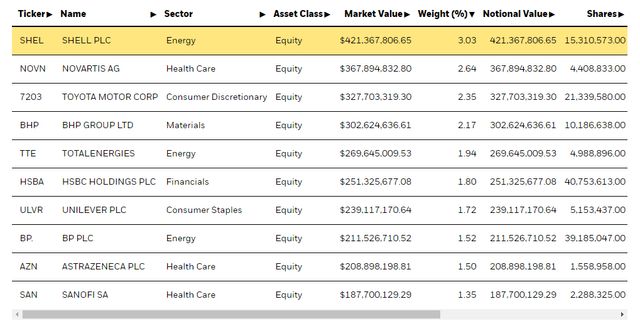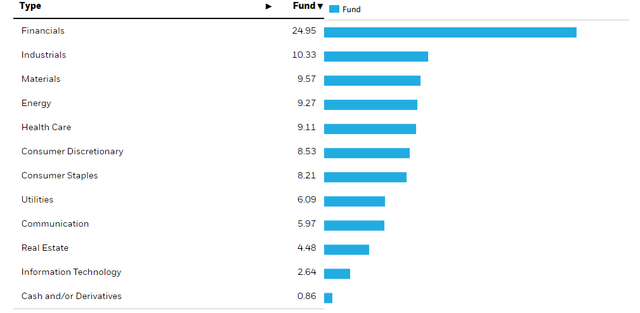
Dilok Klaisataporn
The iShares MSCI EAFE Value ETF (BATS:EFV) contains a lot of what investors might traditionally consider value. Non-tech stocks, but still pretty large cap, that trade at relatively cheap valuations across international markets, skirting also the overpriced US market quite a lot. In EFV’s case, it is primarily skewed towards financials. In the current setup, besides a general interest in higher earnings yield stocks, financials are generally pretty attractive investments as rates hike, as both insurance companies and banks benefit. Overall, EFV looks like a solid pick to stay ahead of rising rates on risk-free securities.
EFV Breakdown
Let’s quickly breakdown the ETF.

Top Holdings (iShares.com)
Top holdings are as seen above. Some of the lower multiple stocks are industrials and commodity stocks whose multiples are pricing in a late stage of the cycle. Nonetheless, these are asset heavy and profitable businesses, often paying strong yields. In the case of energy, to which the EFV has a 10% exposure, prices are likely to remain high for a protracted period of time.
In addition to industrial and energy there is a fair amount of healthcare exposures. Novartis (NVS) and AstraZeneca (AZN) both appear, and both companies are primarily specialty medicine focused, besides the Sandoz division of NVS. Margins are high, and economics are strong. The only threat in the case of some blockbusters that focus on senior markets are new Democrat-passed healthcare reforms. However, neither of these companies are particularly likely to be affected, and in addition to these companies, many in the EFV are highly international pharma companies, many not even primarily US-based.

Sector Breakdown (iShares.com)
The biggest exposure within the fund is to financials. Included are both European and US insurance and banking institutions like Allianz (OTCPK:ALIZF) and HSBC (HSBC). HSBC is not an exposure you want, but thankfully it’s limited. Otherwise, banking benefits from larger net interest margins as savings rates stay low but lending rates rise. On the insurance side, insurance companies are beginning to see improving yields on large portfolios of short term fixed income instruments thanks to higher reference rates. Moreover, pricing in P&C insurance has been favourable for a while, and those robust cash faucets will be valuable as the world becomes increasingly strapped for cash.
Conclusions
A lot of the portfolio lies abroad. Major banking exposures are Japanese, and plenty of European insurance companies feature in the ETF. This is a good thing. US markets are overvalued, and seem to be the only market among asset classes in the US and internationally that haven’t gotten the memo on the economy. Any skews away from US markets now are appreciated and create a margin of safety. The ETF’s P/E is less than 10x, and the yield is 5.76%. This gives you earnings yield to justify the risk above the risk-free reference rate, and a cash yield to give a head start on returns if capital appreciation doesn’t work out. The financial exposure is favourable, so overall the EFV ETF looks like a solid exposure.
While we don’t often do macroeconomic opinions, we do occasionally on our marketplace service here on Seeking Alpha, The Value Lab. We focus on long-only value ideas, where we try to find international mispriced equities and target a portfolio yield of about 4%. We’ve done really well for ourselves over the last 5 years, but it took getting our hands dirty in international markets. If you are a value-investor, serious about protecting your wealth, us at the Value Lab might be of inspiration. Give our no-strings-attached free trial a try to see if it’s for you.



Be the first to comment